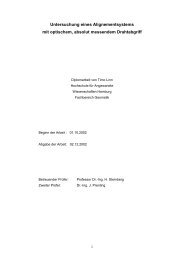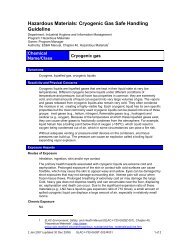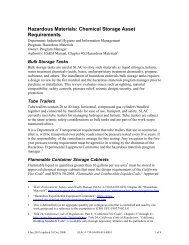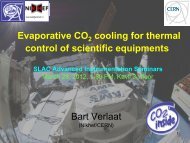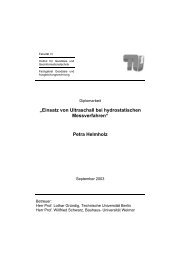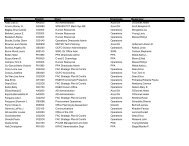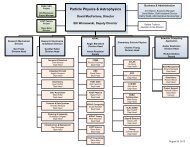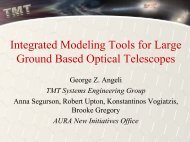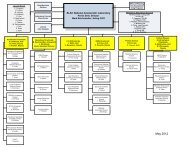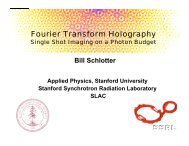BES - SLAC Group/Department Public Websites - Stanford University
BES - SLAC Group/Department Public Websites - Stanford University
BES - SLAC Group/Department Public Websites - Stanford University
Create successful ePaper yourself
Turn your PDF publications into a flip-book with our unique Google optimized e-Paper software.
FYO7 <strong>SLAC</strong> S CIENCE AND T ECHNOLOGY S ELF E VALUATION<br />
linear accelerator is only possible by leveraging the existing linear accelerator to generate<br />
the extreme magnetic fields as well as collaborations with IBM for sample preparation and<br />
magnetic imaging.<br />
Several PULSE experiments use the FEL in Hamburg and therefore provide a unique way<br />
for <strong>SLAC</strong> to explore science that will not be accessible before LCLS is in operation. These<br />
results will be very important to plan future experiments at LCLS and will save time and<br />
resources in future projects at LCLS.<br />
N OTEWORTHY P RACTICES<br />
Bucksbaum Lab<br />
These labs are equipped for the specific research in AMO science, and are prototypical for a laser<br />
lab. For the HHG/Attosecond lab, the requirements on acoustical insulation were very high to<br />
facilitate interferometric experiments with very short wavelengths. Therefore, separate closets for the<br />
vacuum roughing pumps with an isolated cooling air handling system were created. The laser power<br />
supplies and chillers were placed in a commercially available server cooling rack. The rack damps<br />
the noise from the supplies and dissipates their heat by cooling them with a built in fan-heat<br />
exchanger unit that uses the lab cooling water circuit. The table overhead structure was installed to<br />
follow exactly the laser table shape. Flow boxes were installed on top of the table to keep the optical<br />
equipment clean for long times. Whereas the PULSE lab already had a laser that gained great<br />
stability because of the noise and thermal drift reductions, the new lab was equipped with a laser<br />
system, nonlinear optics and pulse shaping devices for coherent control. The PULSE lab is equipped<br />
with a versatile HHG vacuum chamber and an extreme EUV spectrometer. The apparatus has been<br />
optimally tuned and has produced experimental results before and after the remodeling of the lab.<br />
The coherent control lab purchased an amplified femtosecond laser system (Thales), which arrived in<br />
April 2007, was used to pump a home-built Noncollinear Optical Parametric Amplifier (NOPA). The<br />
NOPA pulses are shaped in an AMO pulse shaper to control prototypical biosystems like<br />
bacteriorhodopsin. The whole optical setup operated after only a few weeks and first data are already<br />
available from this lab.<br />
The HHG/Attosecond laboratory received the vacuum ultraviolet (VUV) spectrometer in November<br />
2006. First HHG spectra were taken in December 2006, but the lab work stopped until April 2007<br />
because of the renovations. After lab renovation, a pump-probe setup was used to probe the<br />
alignment of molecules during HHG. Furthermore, interferometric measurements were realized<br />
proving the noise reduction of the lab. Currently, the High Harmonic phase is measured in this lab,<br />
using a reference oscillator. This will give insight in the attosecond pulse shaping possibilities as<br />
well as the generation mechanism of the harmonics in molecules.<br />
A laser lab in <strong>SLAC</strong> Building 130 has provided experience with a custom-built laser system. With<br />
safety procedures and requirements in mind, we have implemented retrofits for older equipment that<br />
brings their safety up to the high standards of the DOE and <strong>SLAC</strong>.<br />
Gaffney Lab<br />
A pump-probe configuration with an OPA for tuning the frequency of the pump pulse and a white<br />
light probe for observing transient changes in the absorption spectrum of materials. These transients<br />
will be detected with a monochromator and CCD camera. A 512 element InGaAs diode array detects<br />
transients in the near-IR.<br />
A four wave mixing set-up was designed to conduct transient grating and photon echo experiments.<br />
The set-up will use diffractive optics for wavelengths ranging from 800 nm to 400 nm, using the<br />
output of the same OPA used for the pump-probe set-up.<br />
A multidimensional vibrational spectroscopy set-up will allow us to conduct a wide area of time<br />
resolved vibrational spectroscopy measurements, including pump-probe and heterodyne detected<br />
photo-echo experiments. We have a 32X2 element HgCdTe diode array for simultaneous<br />
F I N A L P A G E 2 5



